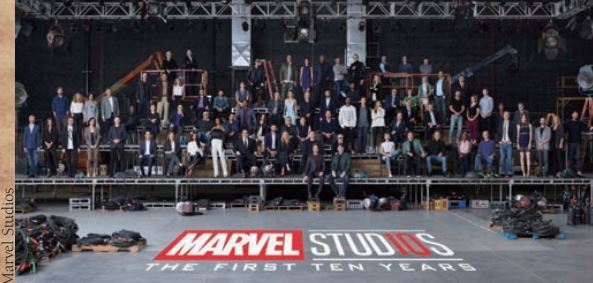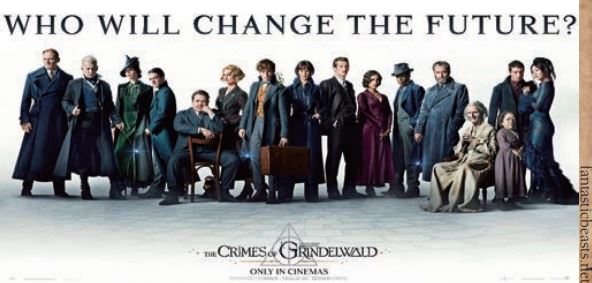On November 14th , the second series of the Harry Potter spin-off Fantastic Beasts: The Crimes of Grindelwald will be released. Fantastic Beasts is an example of “transmedia storytelling” which is involved in the Harry Potter universe. These days, not only Harry Potter but lots of other transmedia universe content also has been gaining great attention through various platforms including novels and movies. The Sungkyun Times (SKT), therefore, introduces the concept of the transmedia storytelling, its usage on several fields, and its expansions.
Creating Its Own World: Transmedia Storytelling
The Concept of Transmedia Storytelling
The term “transmedia storytelling” was coined by media scholar Henry Jenkins. According to Jenkins, transmedia storytelling means the way that the “story universe” appears in diversified media platforms, which are made through media convergence. Consequently, each media expands to develop its own distinctive stories, making an “integral” story universe. Unlike the past, the public nowadays can experience cultural content not only through books but also through a variety of media including the Internet or television (TV). All content from diverse platforms constitutes integral universe content but delivers different stories using its own features of each platform. When experiencing the different content from the same integral story, therefore, the sequence of the story does not matter. It should be fine to experience either a game or movie first. For example, people do not need to watch a movie first in order to play games with a related storyline.

The Marvel Cinematic Universe (MCU) is a movie and drama universe, which is produced by Marvel Studios on the basis of Marvel Comics. Characters in the MCU have their own storylines throughout series such as the Thor, Captain America, and Iron Man movies. In addition, in the movie series Avengers, all these heroes with their own stories appear in the same place at the same time and are connected with one another. Sometimes, a character appears in another movie series of other MCU characters. For example, Iron Man appears in the movie Spider-Man: Homecoming, which contributes to making an integrated Marvel universe. Furthermore, in terms of the spin–off games of MCU, the mobile game Iron Man 3 provides a story related to the original storyline but ultimately distinctive compared to the Iron Man movie series. In the game, players can upgrade Iron Man’s armor with items that they obtain by completing missions. In this regard, each different story is made from different platforms like movies, games, or performances. Those stories eventually make the integrated universe, which is how transmedia storytelling works. Transmedia storytelling consequently makes consumers enter into a unified universe with combined storylines.
Differences from Other Similar Concepts
There are two concepts similar to transmedia that may be confusing: one source multi use (OSMU) and cross-media. OSMU is a model where the original main storyline is adapted through several different media platforms. On the other hand, cross-media unveils literally the same story in all diverse media, but consumers can only see parts of the whole story on each medium. It does not tell the whole story on one media platform. When consumers want to know the whole story, they should look for other crossmedia platforms which convey the continued stories of the same content. After fully seeing all the other parts of the content through other platforms, they could finally appreciate the integrated story.

For instance, the Harry Potter movie or its theme park is OSMU, which just adapts the original Harry Potter novel. The same story appears in slightly different ways through each platform. The Harry Potter spin-offs such as the Fantastic Beasts series and the game Harry Potter: Hogwarts Mystery, on the other hand, are forms of transmedia of the Harry Potter Universe. Unlike OSMU, these transmedia have their own stories on each platform with a slight relationship in the integral Harry Potter universe. In the meantime, a TV advertisement for the Harry Potter movie saying “search on the website for more information!” is cross-media. In this case, a TV advertisement is not a concluded form, so people have to search on the Internet to find different parts of the story from the same advertisement content. To sum up, all three different concepts convey the content through various media platforms but they have differences on ‘how’ they convey content.
Transmedia Storytelling in Distinctive Fields
The concept of transmedia storytelling is used in various fields not only in entertainment such as movies or novels but also in marketing or education.
Transmedia Storytelling in Brand Marketing
Transmedia provides consumers with multiple entry points to one story universe. It means that some people would experience the specific universe content through a movie, a game, or a novel and then could enter the broad story universe. All of the media convey different stories, and the universe gets bigger and bigger with more power in constituting the integral storylines. This characteristic of transmedia storytelling is very profitable for the transmedia-entertainment content industry. All stories from each platform work as independent commercial content. As the universe extends, the industry’s profits would be maximized. The most successful Hollywood movie franchises, therefore, are the transmedia storytelling content including the MCU, the Star Wars series and the Harry Potter series with its spin-off Fantastic Beasts series. The Lego Group is a good example of using transmedia in marketing, which makes a “Lego universe” for branding and commercial advancement. Starting from Lego Star Wars, the Lego Group has launched games in which Lego characters appear and produced TV programs and movies such as the Lego Movie. Finally, the Lego Group sells the Lego bricks related to these shows at retail shops. Although only children used to buy and play with Legos in the past, consumers of all ages have started to buy Lego products after experiencing the various Lego content.
There are several criticisms on transmedia marketing that question if consumers would like to move to other content of the same universe after experiencing one type of content. It is, however, undeniable that transmedia storytelling has contributed a lot to the Lego Group’s commercial success.
Transmedia Storytelling in Education
Narrations are one of the most effective ways in education that allow learners to be immersed in a story. Unlike the one-way education in the past only through books, modernnarrative ways have changed along with the advancement of media. In particular, “edutainment,” a combined word of education and entertainment, gives the experience of both learning and entertaining to consumers. Since edutainment cannot accomplish its purpose through only one platform, however, it needs transmedia storytelling.
The educational comic series The Magic Thousand-Character Classic is an example of transmedia edutainment content. The comic teaches readers Chinese characters through the storyline. This story also contains a card game that teaches players Chinese characters in an entertaining way. Moreover, there is another comic series in the same universe, called The Magic Thousand-Character Classic: Science Expedition or Mathematics Expedition. The characters of the comics are similar because they are in the same universe, but they have totally different storylines as they teach different subjects to children: Chinese characters, science or mathematics.

Although various kinds of education have been done through transmedia storytelling, there are several criticisms of it. Transmedia storytelling education may not be effective due to the children’s deficiency of cognitive maturity. Generally, children between the ages of two to seven lack logical reasoning, which means that they do not understand how the actions of characters can affect the whole storyline of the narrative content. Moreover, as infants still lack understanding even in normal narrative ways, it is quite clear that they would not understand the universe or relativeness of transmedia features. Therefore, some people doubt the necessity of the transmedia content for children education.
Further Expansion of the Universe
Advancement of Participatory Culture
Expanding the integral universe with consumers is the most representative and important feature of transmedia. Nowadays, consumers can participate in transmedia storytelling by reading books, watching movies, playing games, and writing new related stories. When people consume specific content, they can criticize the content and create new ones at the same time. Those acts can be explained as a concept of “story retelling.” In order to do story retelling, consumers should understand the original content, integrate the information they find and produce secondary creations. Nowadays, with the development of new media platforms, secondary creations from one original content have been produced through diverse forms of morphed novels and parody videos. These new creations are usually made by fandoms of transmedia storytelling content. The fan fiction (fanfic) is a typical type of secondary creation by fandom. On the biggest Western fanfic site, fanfiction.net, there are more than 70 million fanfics of the Harry Potter series alone. Fanfics usually use the same characters or the backgrounds from the original story, but they are new content with a variety of theme changes such as parallel world traveling, sex-changing, or time traveling. Parody videos like fan-made dramas are also secondary creations with different storylines from the original content. Fan-made goods are another example of transmedia storytelling, whose universe is broadened by the participation of consumers. This feature where consumers can actively participate in making universe story content, not just accepting them, is a positive function of transmedia content.
The Emergence of Transmedia Storytelling in Korea
In Korea, lots of K-Pop singers have used transmedia storytelling broadly to promote their concepts through various media other than music. The utilization of transmedia storytelling in K-pop began to advance extensively due to the Korean boy group EXO. When it made its debut, EXO had the universal story that the members came from the exoplanet and that each member had supernatural powers. They emphasized the storyline through music videos and music video teasers. The stories in each video, however, were fragmentary with some blanks in the whole narrative plots of EXO’s integral storyline. Therefore, the fandom of EXO searched for missing plots and analogized the blanks in the content. Moreover, the secondary creations such as fanfics or goods have been made and consumed by the fandom on the basis of EXO’s universal storyline.
Transmedia in Korea has begun to catch more people’s attention since the world-famous boy group BTS extensively used it. They have released series albums such as School Trilogy or The Most Beautiful Moment in Life sequel, which have specific themes in one integral storyline. For example, School Trilogy is about teenagers’ dreams and love through which BTS builds its image as if it were representing teenagers. The next series album The Most Beautiful Moment in Life sequel has made BTS branch out and grow up from the concept as teenagers to young adults in their twenties, by singing about youth. BTS has progressed its universe’s storytelling through music videos of which the storylines and content are integrated with each other in one integral narrative story. Transmedia storytelling has also been used in the Korean movie Train to Busan. Train to Busan is the expanded story of the same director’s prequel animation called Seoul Station. Those two are totally distinctive stories but have a slight relation to each other. For instance, the video seen in the TV monitor in Train to Busan is about the world in Seoul Station.

Harry Potter and the MCU are representatives of globally successful movie series in the international movie industry. A similarity between them is that transmedia storytelling plays a key role in their success. From now on, within the persistently diversifying media platforms, transmedia storytelling content in Korea might also be advanced. In this sense, Kingos’ interests may also be necessary as they are the main consumers in the future until the Korean version of Harry Potter is made.
